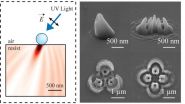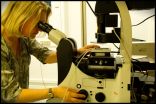(Press-News.org) An international research team that includes researchers from Lawrence Livermore National Laboratory has captured the highest-resolution protein snapshots ever taken with an X-ray laser, revealing how a key protein in a photosynthetic bacterium changes shape when hit by light.
Human biology is a massive collection of chemical reactions and all involve proteins, known as the molecules of life. Scientists have been moving steadily toward their ultimate goal of following these life-essential reactions step by step in real time, at the scale of atoms and electrons.
"These results establish that we can use this same method with all kinds of biological molecules, including medically and pharmaceutically important proteins," said Marius Schmidt, a biophysicist at the University of Wisconsin-Milwaukee who led the experiment at the Department of Energy's SLAC National Accelerator Laboratory. "We are on the verge of opening up a whole new unexplored territory in biology, where we can study small but important reactions at ultrafast timescales."
The results, detailed in the Dec. 5 issue of Science, have implications for research on some of the most pressing challenges in life sciences, which include understanding biology at its smallest scale and discovering molecular targets for drug design.
The experiment took place at SLAC's Linac Coherent Light Source (LCLS). LCLS's X-ray laser pulses, which are about a billion times brighter than X-rays from synchrotrons, allowed researchers to see new atomic-scale details of how the bacterial protein changes within millionths of a second after it is exposed to light.
Lawrence Livermore researchers Mark Hunter, Brent Segelke and Matthias Frank contributed to the work in sample preparation, laser setup and conducting the experiment.
The experimental station used in the study. LCLS pulses, measured in quadrillionths of a second, work like a super-speed camera to record ultrafast changes, and snapshots taken at different points in time can be compiled into detailed movies.
"This experiment marks the first time that LCLS has been used to directly observe a protein's structural changes at such a high resolution as it happens," Frank said.
The protein the researchers studied, found in purple bacteria and known as PYP for "photoactive yellow protein," functions much like a bacterial eye in sensing certain wavelengths of light. The mechanism is very similar to that of other receptors in biology, including receptors in the human eye.
"Though the chemicals are different, it's the same kind of reaction," said Schmidt, who has studied PYP since 2001. Proving the technique works with a model protein like PYP sets the stage to study more complex and biologically important molecules at LCLS, he said.
In the LCLS experiment, researchers prepared crystallized samples of the protein, and exposed the needle-shaped crystals, each about 2 millionths of a meter long, to optical laser light before jetting them into the LCLS X-ray beam.
The incident X-rays produced diffraction patterns as they struck the crystals, which are used to reconstruct the 3-D structures of the proteins. Researchers compared the structures of the light-exposed proteins to structures of proteins that had been held in the dark to identify light-induced structural changes.
"In this work, we were observing structural changes on a microsecond timescale that were essentially known previously in order to demonstrate the potential of this method. We are looking forward to our next series of LCLS experiments in 2015, where we will enter uncharted territory and will attempt to probe structural changes in the same protein on much shorter time scales," Frank said.
"In the future we plan to study all sorts of enzymes and other proteins using this same technique," Schmidt said. "This study shows that the molecular details of life's chemistry can be followed using X-ray laser crystallography, which puts some of biology's most sought-after goals within reach."
INFORMATION:
Other contributors include Arizona State University; University of Hamburg and DESY in Hamburg, Germany; State University of New York, Buffalo; University of Chicago; and Imperial College in London. The work was supported by the National Science Foundation, National Institutes of Health and Lawrence Livermore National Laboratory.
Founded in 1952, Lawrence Livermore National Laboratory is a national security laboratory, with a mission to ensure national security and apply science and technology to the important issues of our time. Lawrence Livermore National Laboratory is managed by Lawrence Livermore National Security, LLC for the U.S. Department of Energy's National Nuclear Security Administration.
(SAN FRANCISCO, December 6, 2014) - Novel treatments that harness the body's own immune cells to attack cancer cells demonstrate safe and durable responses in patients with relapsed and treatment-resistant blood cancers, according to data presented today at the 56th American Society of Hematology (ASH) Annual Meeting and Exposition.
Therapies designed to target the immune system and ignite the body's own disease-fighting mechanisms have become an increasingly promising field of study, particularly in blood cancers. While the immune system can easily recognize viruses ...
Researchers from North Carolina State University have developed a new lithography technique that uses nanoscale spheres to create three-dimensional (3-D) structures with biomedical, electronic and photonic applications. The new technique is significantly less expensive than conventional methods and does not rely on stacking two-dimensional (2-D) patterns to create 3-D structures.
"Our approach reduces the cost of nanolithography to the point where it could be done in your garage," says Dr. Chih-Hao Chang, an assistant professor of mechanical and aerospace engineering ...
Nature's ingenious systems: A layer of cells called endothelial cells lines the interior of blood vessels. When blood flows through the vessels, such cells only divide to replace dead cells. However, if there is a blood clot preventing blood from flowing across the endothelial cells, they begin to divide more actively. New research from the Niels Bohr Institute demonstrates that cell division is very ordered. The new cells move away from each other and create a dynamic movement with eddies in a large area. This presumably helps to widen the vessel around the blockage. The ...
A new study by researchers at the University of Exeter has found early warning signals of a reorganisation of the Atlantic oceans' circulation which could have a profound impact on the global climate system.
The research, published today in the journal Nature Communications, used a simulation from a highly complex model to analyse the Atlantic Meridional Overturning Circulation (AMOC), an important component of the Earth's climate system.
It showed that early warning signals are present up to 250 years before it collapses, suggesting that scientists could monitor ...
Cancer Research UK scientists have discovered a new line of defence used by cancer cells to evade cell death, according to research published in Nature Communications* today (Monday).
The team identified a critical pathway of molecular signals which throw a lifeline to cancer cells, enabling them to survive even though they contain vast DNA errors which would usually trigger cell death.
The PKCƐ signal pathway**, which is used by cancer cells but rarely by normal cells, could be important in targeting some cancer cells as they rely on this pathway to survive.
The ...
UPTON, NY-A team of scientists from the U.S. Department of Energy's (DOE) Brookhaven National Laboratory, Columbia Engineering, Columbia Physics and Kyoto University has discovered an unusual form of electronic order in a new family of unconventional superconductors. The finding, described in the journal Nature Communications, establishes an unexpected connection between this new group of titanium-oxypnictide superconductors and the more familiar cuprates and iron-pnictides, providing scientists with a whole new family of materials from which they can gain deeper insights ...
A new analysis has found that while clinical trial data support omitting radiation treatments in elderly women with early stage breast cancer, nearly two-thirds of these women continue to receive it. The findings are published early online in Cancer, a peer-reviewed journal of the American Cancer Society.
Results published in 2004 from a large, randomized clinical trial showed that adding radiation therapy to surgery plus tamoxifen does not reduce 5-year recurrence rates or prolong survival in elderly women with early stage tumors. Despite the findings, many doctors still ...
DURHAM, N.C. - Women over the age of 70 who have certain early-stage breast cancers overwhelmingly receive radiation therapy despite published evidence that the treatment has limited benefit, researchers at Duke Medicine report.
The study suggests that doctors and patients may find it difficult to withhold treatment previously considered standard of care, even in the setting of high quality data demonstrating that the advantages are small.
"The onus is on physicians to critically analyze data to shape our treatment recommendations for patients, weighing the potential ...
Dublin, IRELAND Monday December 8th, 2014 - Millions of documents stored in archives could provide scientists with the key to tracing agricultural development across the centuries, according to new research completed at Trinity College Dublin and the University of York.
Amazingly, thanks to increasingly progressive genetic sequencing techniques, the all-important historical tales these documents tell are no longer confined to their texts; now, vital information also comes from the DNA of the parchment on which they are written.
Researchers used these state-of-the-art ...
Metabolic syndrome is linked with an increased frequency and severity of lower urinary tract symptoms, but weight loss surgery may lessen these symptoms. The findings, which come from two studies published in BJU International, indicate that urinary problems may be added to the list of issues that can improve with efforts that address altered metabolism.
Lower urinary tract symptoms related to urinary frequency and urgency, bladder leakage, the need to urinate at night, and incomplete bladder emptying are associated with obesity in both men and women. To see if these ...




